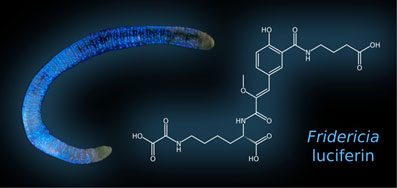Press-room / news / Science news /
Novel luciferin from Siberian bioluminescent worm
The structure of a novel luciferin was determined for the first time in the last 25 years as a result of collaboration between groups from IBCh RAS (Moscow) and IBP SB RAS (Krasnoyarsk) — results published in Angewandte Chemie IntEd.
In 1990 in taiga forests in Krasnoyarsk region Valentin Petushkov and Natalya Rodionova (Institute of Biophysics of Siberian Branch of the Russian Academy of Sciences, Krasnoyarsk) discovered a new species of luminous earthworms, which was later classified as Fridericia heliota. These small worms (the mass of an individual worm does not exceed 2 mg) possess an ability to emit light-blue glow in response to mechanical stress. It was another 10 years of investigations before Petushkov and co-workers managed to isolate the components of the bioluminescent system from these wonderful creatures. Several thousands of earthworms were collected and mechanically processed in order to obtain the necessary amount of biomaterial!

But how do these worms glow? What is the mechanism of their bioluminescence? Not only Fridericia heliota species are luminescent, there are also numerous examples of luminous bugs, bacteria, corals, jellyfish, fungi and other creatures. Light emission by a live organism is a result of a chemical reaction of oxidation of a small organic molecule (called luciferin) by an oxidant (usually oxygen) in the presence of a specific enzyme — luciferase.
The phenomenon of bioluminescence finds various practical applications. It is used for environmental monitoring in ecology; in medicine and pharmaceutical science bioluminescence is applied for clinical analyses and in test-systems for drug research. In biochemical investigations bioluminescence is used for visualization of physiological processes in cells and whole organisms as well as for detection of various analytes, such as ATP. The most informative way to visualize the protein action within the cells is also based on luciferin-luciferase interaction: the luciferase fragment is attached to the protein of interest and luciferin is added to the cell culture.
For practical application of bioluminescence in science one needs to know the structures of luciferin and luciferase and also understand the mechanism of interaction between them. Until now only seven structures of natural luciferins were known, the last of which was established more than 25 years ago.
In 2012 having obtained only 5 micrograms of luciferin, isolated from Fridericia heliota earthworms, group of Valentin Petushkov set up a collaboration with Total Synthesis group of Ilia Yampolsky and M. Dubinnyi and K. Nadezhdin from the Laboratory of biomolecular NMR‑spectroscopy (Institute of Bioorganic Chemistry RAS) to elucidate the luciferin’s structure. The Fridericia heliota project got financial support from Russian government — “megagrant”, which was headed by the renowned Nobel laureate Osamu Shimomura, who conducted pioneer investigations of bioluminescence phenomenon.
By joint efforts of the specialists in organic synthesis and NMR spectroscopy the structure of luciferin was revealed from this exceptionally small amount of substance. It was shown that the luciferin is an unusual peptide composed of residues of lysine, oxalic and gamma-aminobutyric acids and a tyrosine modification. The structure was confirmed by total synthesis and synthetic luciferin was found to be identical to the natural substance.
The discovered luciferin from Fridericia heliota is non-toxic, easily synthesized and remarkably stable in the presence of air and in water solutions (unlike bacterial luciferin) — hence it could be widely used for applied technologies, for example as a biomarker in screening for drug candidates.
The main research task of the collaborators in the future is the determination of luciferase structure along with the establishment of the pathway of luciferin biosynthesis. These studies will help to transfer bioluminescence from earthworms to another eukaryotic organism.
april 16, 2014
Source: http://onlinelibrary.wiley.com/doi/10.1002/anie.201400529/abstract

